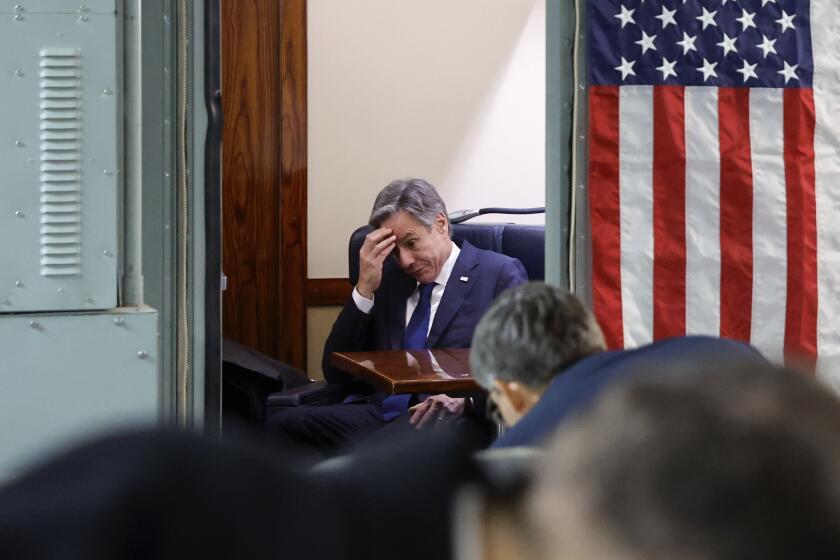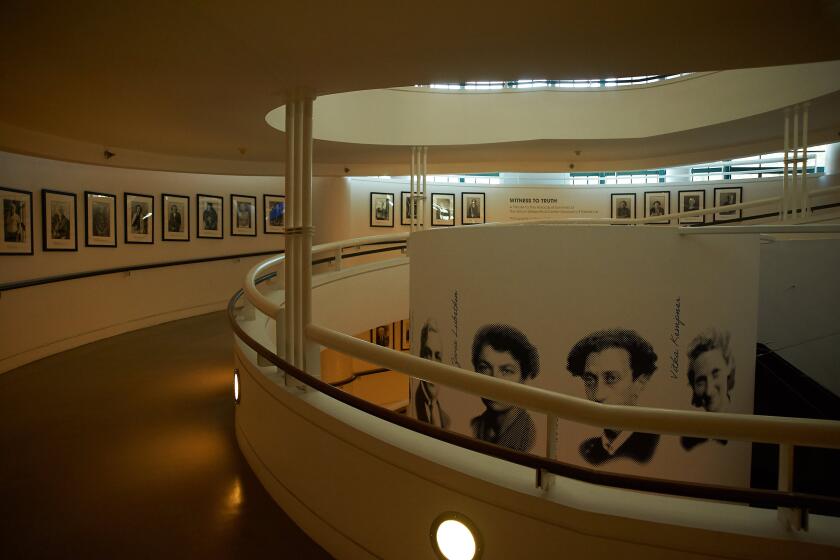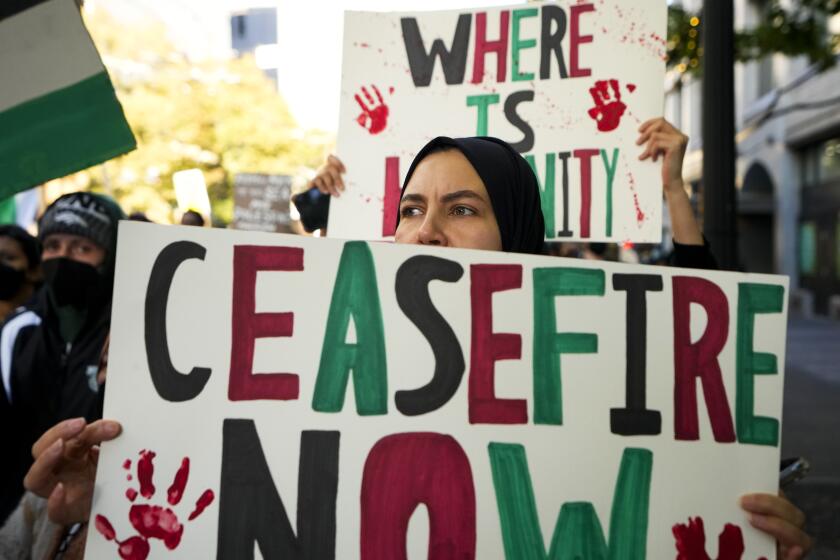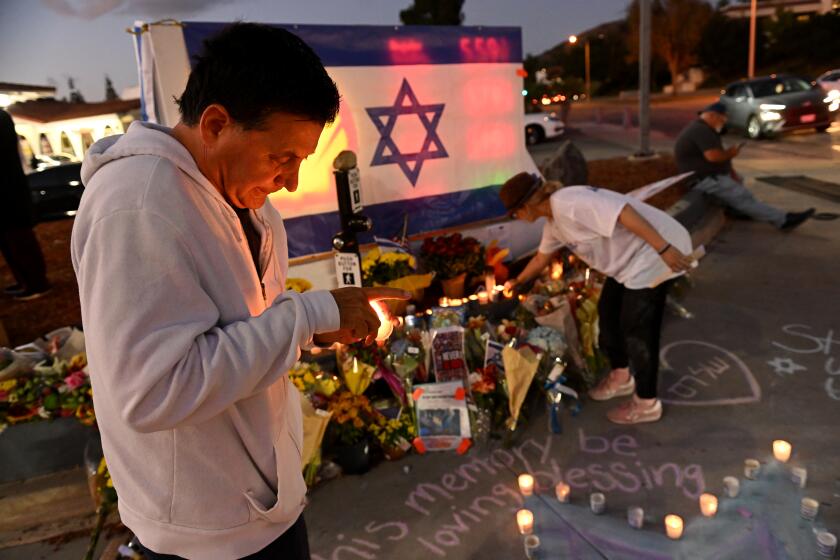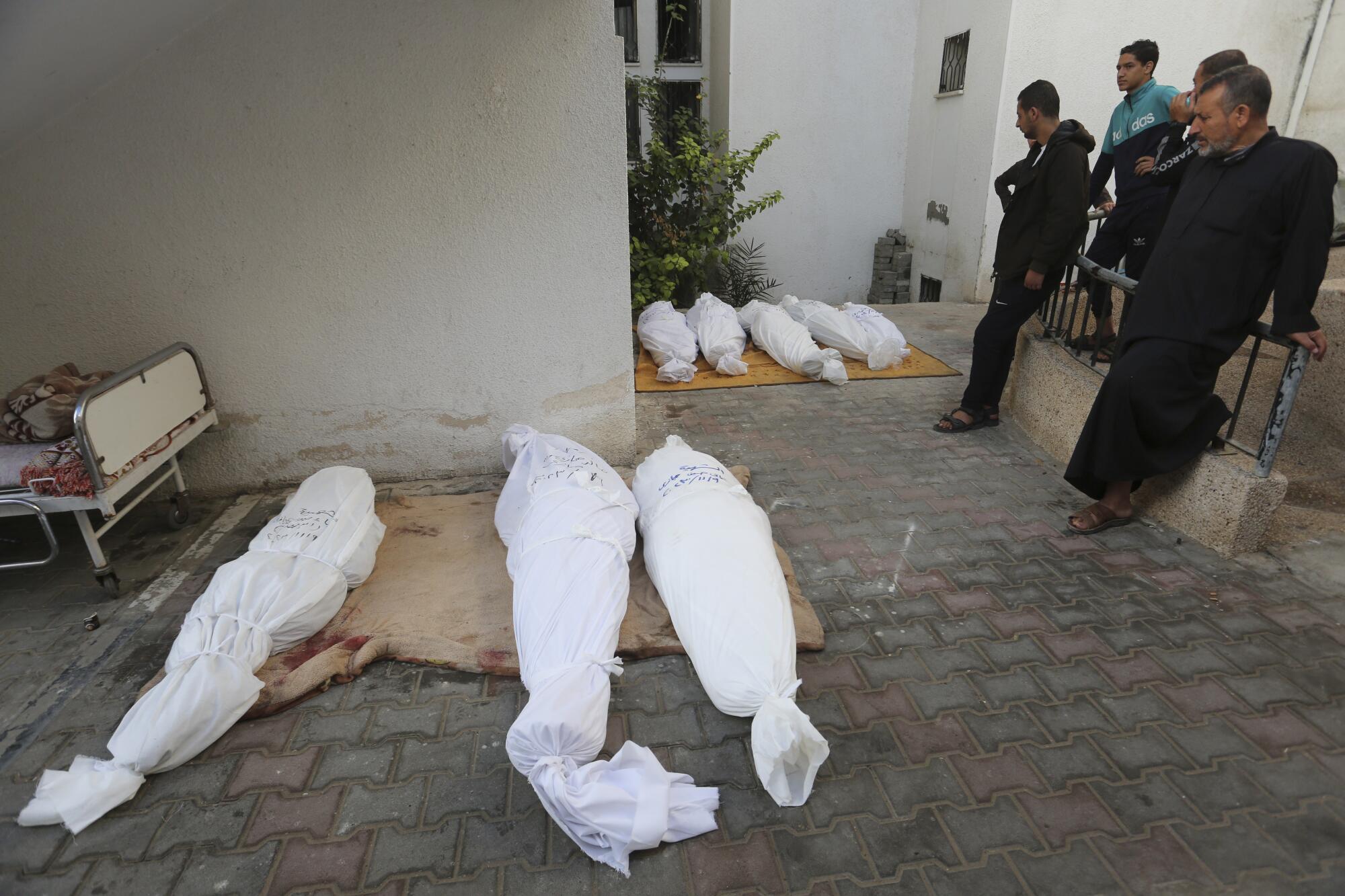
- Share via
DEIR AL BALAH, Gaza Strip — Thousands of Palestinians sheltering from the Israel-Hamas war at Gaza City’s main hospital fled south Friday after several reported strikes in and around the compound overnight. They joined a growing exodus of people amid intensified fighting in the north as Gaza officials said the Palestinian death toll from the war had surpassed 11,000 people.
The search for safety across the besieged Gaza Strip has grown more desperate as Israel has intensified its assault on the territory’s largest city.
The Israeli army says that Hamas’ military infrastructure is based amid Gaza City’s hospitals and neighborhoods and that it has set up its main command center in and under the largest hospital, Shifa — claims the militant group and Shifa staff deny. Israel has vowed to destroy Hamas after its deadly Oct. 7 surprise incursion.
More than 100,000 Palestinians have fled south over the last two days, according to Israel, with thousands streaming onto Gaza’s only highway Friday, fleeing the combat zone in the north after Israel announced a window for safe passage.
But they still face the prospect of ongoing bombardment and dire conditions. The overnight strikes in northern Gaza underscored the danger for tens of thousands more who have sought shelter in and around hospitals.
Gaza medical officials accused Israel of striking near four hospitals Friday. Israel said at least one of the strikes was a misfired Palestinian rocket.
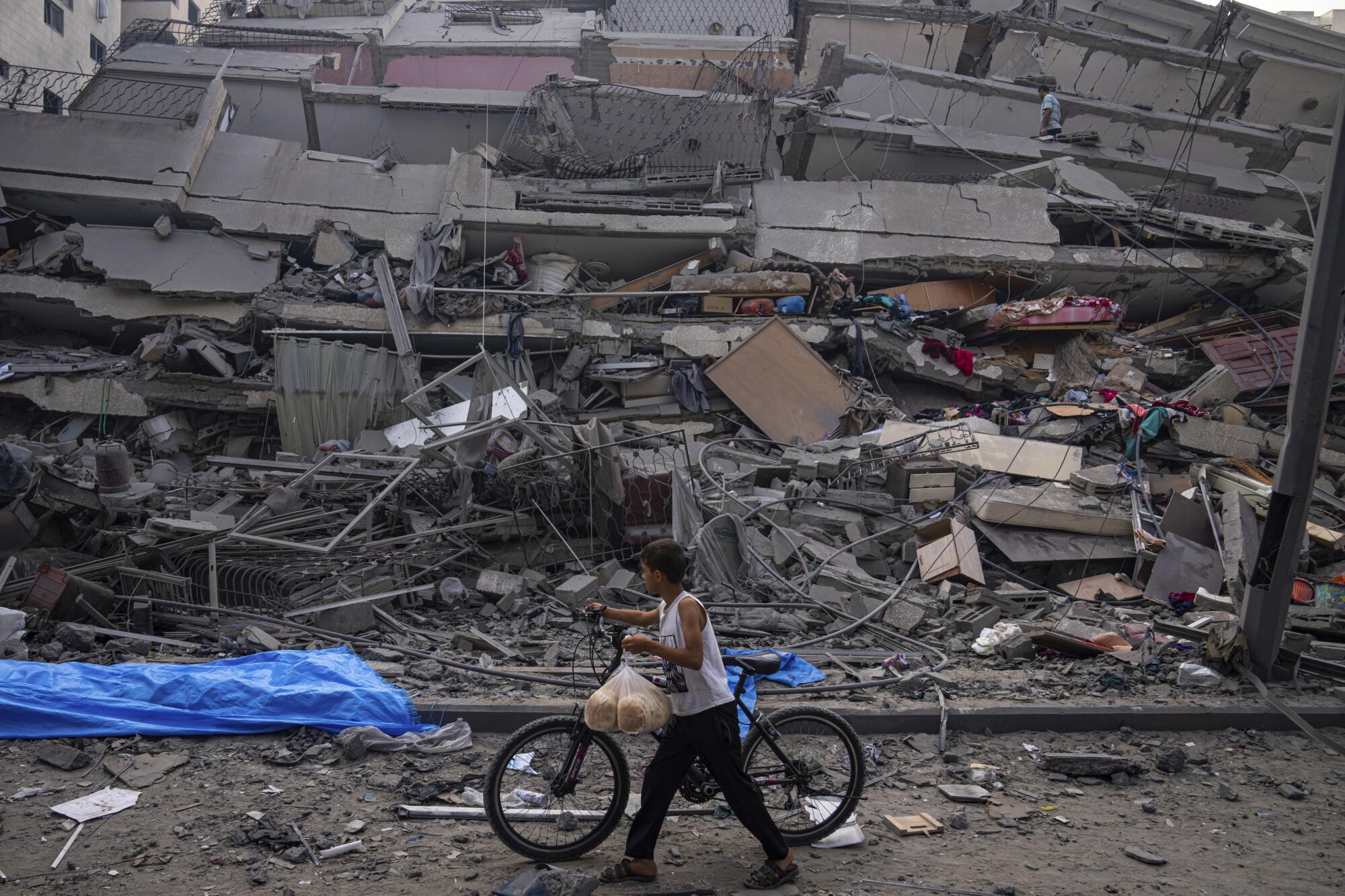
Gaza City, the coastal enclave’s largest, is the focus of Israel’s campaign to crush Hamas following the militant group’s Oct. 7 rampage in southern Israel in which at least 1,200 people, most of them civilians, were killed, according to the military, and more than 200 others kidnapped.
Early Friday, Israel struck the courtyard and the obstetrics department of Shifa Hospital, where people are sheltering, according to Ashraf Qidra, a spokesperson for the Health Ministry in Hamas-run Gaza.
The U.S. should be well-positioned to sway Israel and Arab allies in containing the crushing Gaza war. But the Biden administration’s efforts are falling short.
A video at the scene recorded the sound of incoming fire waking up people in their makeshift shelters in the courtyard, followed by shouts for an ambulance. In the blood-spattered courtyard, one man writhed, screaming on the ground, his leg apparently severed.
Qidra blamed the attack on Israel, a claim that could not be independently verified.
For weeks, tens of thousands of displaced people — reaching as many as 60,000 this week, according to the Health Ministry — have been sheltering at the Shifa complex, hoping it would prove safe.
But the overnight strikes triggered a mass exodus of the displaced. At around 10 a.m., large numbers packed up their belongings and began streaming out, walking toward the south, five of those who left told the Associated Press.
Qidra told the Qatar-based satellite news network Al Jazeera on Friday that more than 30,000 displaced people, medical workers and patients remained in the hospital.
Those who stayed were mainly people who couldn’t walk or who didn’t know where to go, said Wafaa abu Hajajj, a journalist who arrived in the south after leaving the hospital Friday.
“The strikes were hoping to scare people, and it worked. It was too intense and it became too much,” said 32-year-old Haneen Abu Awda, who had been at Shifa being treated for wounds from an earlier strike on their home.
Shifa has been overwhelmed by thousands of wounded, even as it operates with minimal power and medical supplies.
In video released Friday by the Health Ministry, the limp bodies of children are seen lying on stretchers across blood-stained floors in the hospital, some apparently dead and others barely breathing. Other patients were strewn around the floor, unable to be treated for lack of supplies. One man is seen gasping for air.
The director of Shifa said Israel had demanded that the hospital be evacuated, but he said there was nowhere for such a large number of patients to go.
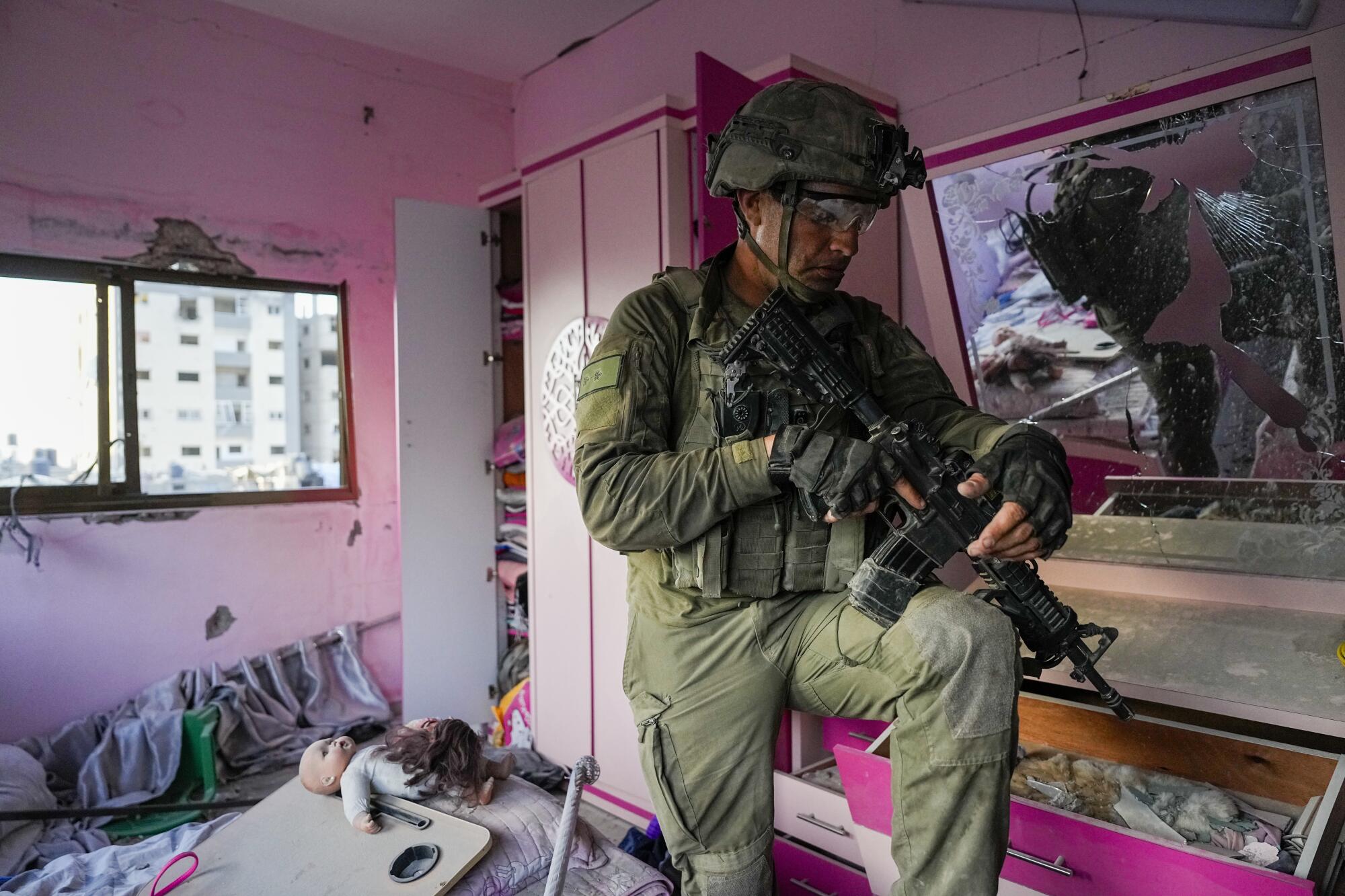
“Where are we going to evacuate them?” hospital director Muhammad Abu Salima said in an interview on Al Jazeera.
Gaza’s Health Ministry later said one person had been killed at Shifa and several wounded. A senior Israeli security official said initial findings indicated that one strike at Shifa was the result of a misfire by militants. The military is conducting a review. The official spoke on condition of anonymity because the investigation is ongoing.
Another strike near the Al-Nasr Medical Center, which includes two hospitals for children, killed two people, according to the ministry. Shifa Hospital’s Abu Salima said at least 25 people were killed when a strike hit a Gaza City school where people were sheltering.
The strike forced the shutdown of Nasr’s children’s hospital, the only remaining site offering specialized pediatric care in north Gaza, said World Health Organization spokesperson Margaret Harris. She said it wasn’t known what happened to patients there, including children receiving dialysis and on life support — “things that you cannot possibly evacuate them safely with.”
Qidra, the Health Ministry spokesman, said ambulances could not reach Nasr hospital to evacuate patients due to Israeli strikes.
Israeli military spokesman Lt. Col. Richard Hecht said Israel is “aware of the sensitivity” of hospitals and that forces were closing in on them slowly. Israel “does not fire on hospitals,” he said, but if militants are seen firing from them, “we will do what we need to do” and kill them.
Israel has produced video that it says is evidence that Hamas uses not only hospitals, but schools and mosques as well, as cover for military activities.
United Nations Secretary-General Antonio Guterres has said that Hamas uses civilians as “human shields,’’ while stressing that this does not give Israel free rein to target buildings where militants may be hiding among civilians. He has pointed to international humanitarian law, which states that protection of civilians and hospitals, schools and homes is paramount.
As a small number of protesters gathered Wednesday outside the Museum of Tolerance, about 150 viewers screened footage from the Oct. 7 attacks, compiled by the Israel Defense Forces.
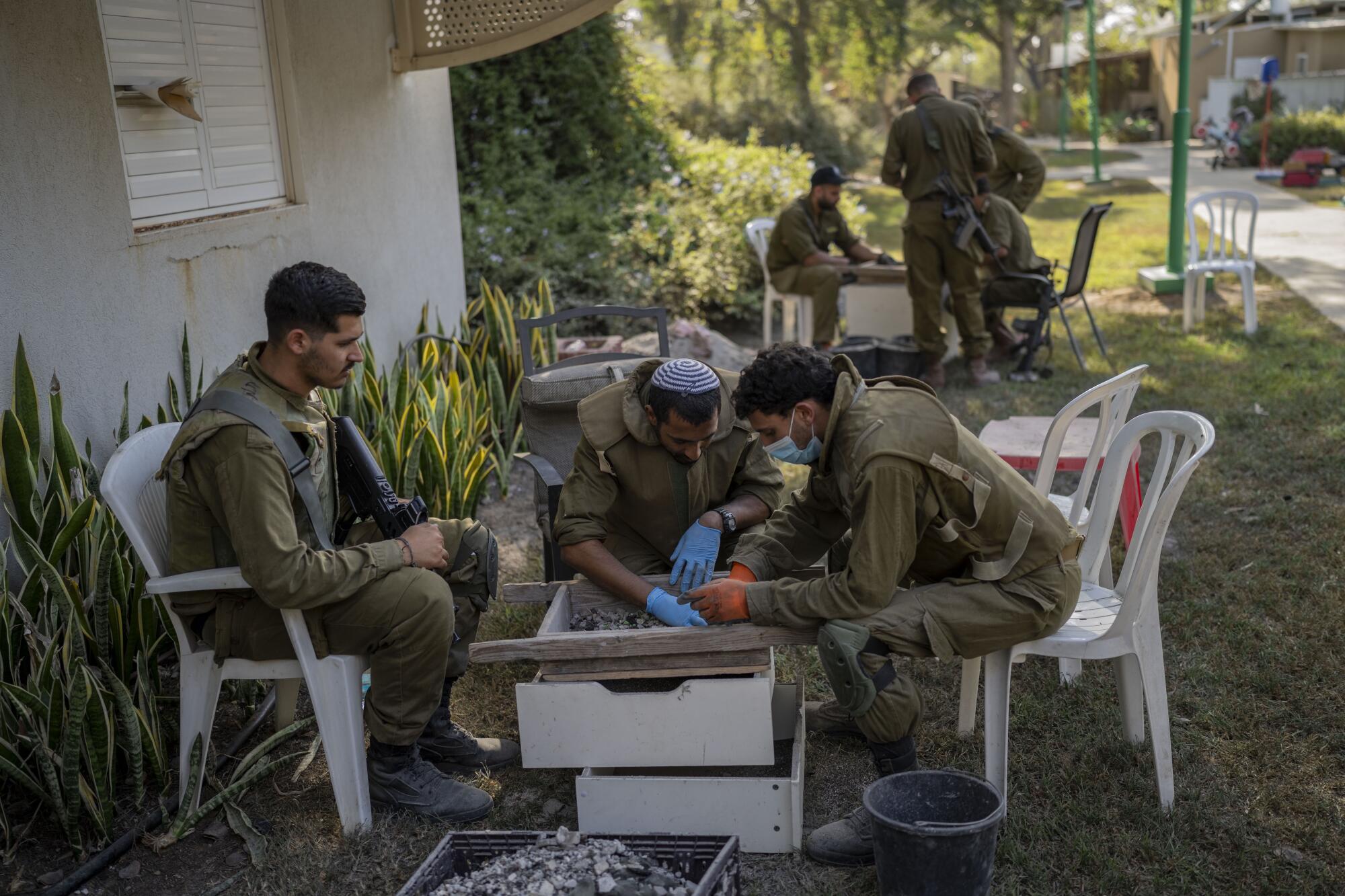
More than two-thirds of Gaza’s population of 2.3 million have fled their homes since the war began. On Friday, a steady stream of civilians traveled south on both sides of Gaza’s main north-south highway. With no fuel for vehicles, the crowds walked for hours as explosions echoed a short distance away. Among them were wounded and older people.
Parents walked with small children, some evacuees crammed into covered donkey carts with possessions piled on the roof, and others rode on bicycles.
An expanded Palestinian government and PLO — including Hamas — must rule Gaza and the West Bank and negotiate to establish a Palestinian state.
Many arrived in the central city of Deir al Balah on Friday, hungry, exhausted and with a stew of emotions — relief, rage and despair.
Reem Asant, 50, described winding through the streets on the way out of Gaza City, trying to avoid shelling.
“We’re talking about children killed in a hospital,” shouted one man, Abu Yousef, his voice rising with fury. “Hundreds of women killed every day. Houses collapsing on the heads of civilians.”
“Where are human rights?” he asked. “Where is the United Nations? Where is the United States? Where is the International Criminal Court? Where is the entire world?”
The Israeli military had announced an expanded six-hour window on Friday for civilians to escape northern Gaza along Salah al Din, the route used since last weekend. It also announced the opening of a second route, along the coastal road, after an agreement announced by the White House a day earlier.
The White House said Israel had agreed to implement a brief humanitarian pause each day — in what appeared to be an effort to formalize and expand the process.
In all, Israel estimated that more than 850,000 of the 1.1 million people in northern Gaza had left, according to military spokesman Jonathan Conricus, who called the pauses “quick humanitarian windows” that allow southward movement “while we are fighting.”
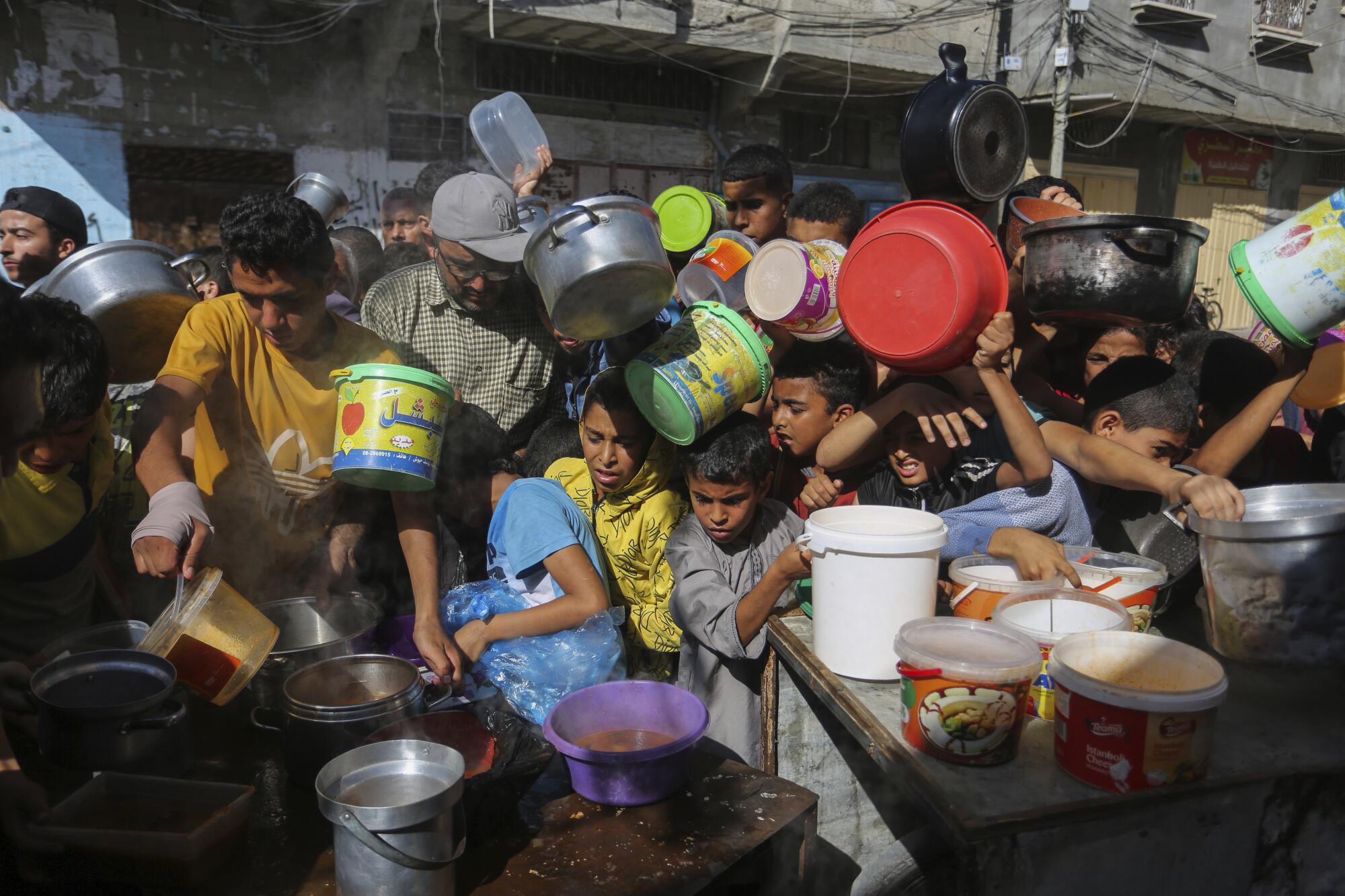
Francesca Albanese, U.N. expert for the Palestinian territories, called the pauses “cynical and cruel,” saying it was just enough “to let people breathe and remember what is the sound of life without bombing, before starting bombing them again.”
More than 11,070 Palestinians, two-thirds of them women and minors, have been killed since the hostilities began, according to the Gaza Health Ministry, which does not not differentiate between civilian and militant deaths. An additional 2,650 people have been reported missing.
U.S. Secretary of State Antony J. Blinken said Friday that “far too many” Palestinians had died and suffered, and that while recent Israeli steps to reduce harm to civilians are positive, they are not nearly enough.
Paul Kessler, a pro-Israel counter-protester, died hours after a confrontation with a pro-Palestinian demonstrator. Officials have identified a suspect, but no one has been arrested.
Though President Biden and others have challenged the figures from the Gaza Health Ministry as exaggerated, Assistant Secretary of State Barbara Leaf told American lawmakers this week that it was “very possible” the numbers were actually even higher than the Gaza Health Ministry reported.
At least 1,200 people have been killed in Israel, mainly in the initial Hamas attack, and 41 Israeli soldiers have been killed in Gaza since the ground offensive began. The Israeli Foreign Ministry had previously estimated the civilian death toll at 1,400, and gave no reason Friday for the revision.
An Israeli official told AP that the number had been changed after the painstaking process to identify bodies, many of which were mutilated or burned in the Hamas rampage. The final death toll could still change, according to the official, who spoke on condition of anonymity pending a formal announcement.
Palestinian militants have continued to fire rockets into Israel, and an attack on Tel Aviv wounded at least two people Friday, said Yossi Elkabetz, a paramedic with Israel’s rescue services. Hamas claimed responsibility.
Some 250,000 Israelis have been forced to evacuate from communities near Gaza and along the northern border with Lebanon, where Israeli forces and Hezbollah militants have traded fire repeatedly.
More to Read
Sign up for Essential California
The most important California stories and recommendations in your inbox every morning.
You may occasionally receive promotional content from the Los Angeles Times.
